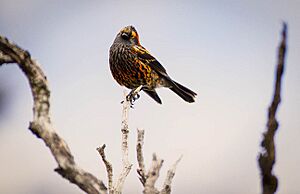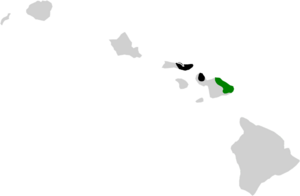ʻAkohekohe facts for kids
Quick facts for kids ʻĀkohekohe |
|
|---|---|
 |
|
| Conservation status | |
| Scientific classification | |
| Genus: |
Palmeria (bird)
|
| Species: |
dolei
|
 |
|
| Black: Extinct Green: Current range |
|
The ʻākohekohe (pronounced ah-koh-HEH-koh-heh), also called the crested honeycreeper, is a special bird found only on the island of Maui in Hawaiʻi. It's a type of Hawaiian honeycreeper. This bird is in danger because of a disease called avian malaria, which mosquitoes carry. Because of this, the ʻākohekohe only lives and has its babies in wet forests high up in the mountains (over 1,715 meters or 5,627 feet).
Contents
What Does the ʻĀkohekohe Look Like?
The ʻākohekohe is the biggest honeycreeper bird on Maui. It grows to be about 16.5 to 18 centimeters (6.5 to 7 inches) long. Adult birds are shiny black. They have white feathers and stripes along their sides. Their belly feathers are whitish-black.
Unique Features of the ʻĀkohekohe
The top of their wings have bright orange feathers. Behind their eyes, the feathers are reddish. A stream of cream-colored feathers comes from their eyes. One of the most noticeable things about this bird is the whitish-gold feather crest on its head. Young ʻākohekohe birds are brownish-black. They do not have the orange feathers that their parents do. Their legs and beaks are black.
ʻĀkohekohe Bird Songs
The ʻākohekohe makes many different sounds. Its most famous call sounds like whee-o, whee-o, repeated often. Another well-known song is a thrilling sound that goes down in pitch. It repeats about every five seconds. Its calls also include a low chuckling sound, like tjook, tjook, chouroup. Sometimes, it makes a rarer sound, hur-hur-hur-gluk-gluk-gluk.
What the ʻĀkohekohe Eats
The ʻākohekohe is a nectarivore. This means it mostly eats nectar from flowers. It especially loves the flowers of the ʻōhiʻa lehua tree (Metrosideros polymorpha). These trees grow high up in the forest canopy. The ʻākohekohe is a very protective bird. It will chase away other birds that try to eat the nectar. This includes other honeycreepers like the ʻapapane and ʻiʻiwi.
When ʻōhiʻa lehua flowers are hard to find, the ʻākohekohe will eat other things. It will eat insects, fruit, and nectar from different plants. If it needs to, it will look for food in the lower parts of the forest. Here, it might find plants like the ʻākala (Rubus hawaiensis).
Where the ʻĀkohekohe Lives
The natural habitat of the ʻākohekohe is wet forests. These forests are mostly made up of koa (Acacia koa) and ʻōhiʻa lehua trees. They are found on the windward side of Haleakalā volcano. These birds live at elevations from about 1,280 to 2,164 meters (4,200 to 7,100 feet).
During a study in the east Maui forests, scientists found 415 ʻākohekohe birds. They were spread over an area of about 45 square kilometers (11,000 acres). It is thought that only about 3,800 ʻākohekohe birds are left on Maui. They live in two groups separated by a place called the Koʻolau Gap. Sometimes, but not often, people can see them at Hosmer's Grove in Haleakalā National Park.
Why the ʻĀkohekohe is in Danger
The ʻākohekohe now only lives on Maui. But it used to live on the eastern side of Molokaʻi island too, until 1907. This bird was common on both islands in the early 1900s. People thought it was gone forever after that. However, in 1945, a small group was found on Haleakalā in Maui.
Over thousands of years, the number of ʻākohekohe birds has gone down. When the first humans, the Polynesians, came to Hawaiʻi, they changed the land. They cut down forests for homes and farms. This caused many birds to lose their homes. They also brought the Polynesian rat (Rattus exulans). These rats ate bird eggs and chicks.
When Europeans arrived, the problems for the birds got worse. Europeans brought two more types of rats. These rats also ate eggs, chicks, and even adult birds. They also brought animals like goats and pigs. These animals ate plants and caused more forests to be destroyed. The ʻākohekohe's unique look also made it wanted by collectors.
In the mid-1800s, mosquitoes arrived in Hawaiʻi. Later, these mosquitoes spread diseases like avian malaria and avian pox. Mosquitoes, especially Culex quinquefasciatus, carry these diseases. Hawaiian honeycreepers like the ʻākohekohe do not have a natural way to fight these sicknesses. Because of this, avian malaria causes many Hawaiian honeycreepers to die. Humans also brought other birds that are not native to Hawaiʻi. These new birds compete with native birds for food. They can also carry diseases like avian malaria, which they are immune to, and spread them to the native birds.
Protecting the ʻĀkohekohe
The ʻākohekohe is a protected bird. The Federal Endangered Species Act protects it and its home. This bird was added to the act in March 1967. It was also part of other plans to help save it. One important plan was the Maui-Molokai Forest Bird Recovery Plan in 1967. This plan was made by the Fish and Wildlife Service. It helps guide efforts to protect the native animals of Maui and Molokaʻi.
The final recovery plan in 1984 continues these efforts. It keeps a close watch on the ʻākohekohe. It also works to remove any animals like goats or pigs that are brought into the area. These animals can harm or disturb the ʻākohekohe and other native forest birds in Maui's forests.



